Covering Cakes with Fondant- A Cake Decorating Video Tutorial
In this cake video tutorial, I'll show you the basics of covering a cake with fondant.
Fondant is an edible sugar dough that is used all over the world to create beautiful cakes with a smooth finish.
Table of Contents
What Type of Fondant is Best?
There are many different opinions on the best brands or recipes of fondant.
Satin Ice and Wilton are good options and are not too expensive.
I use Liz Marek's recipe most often which is a combination of pre-made fondant and marshmallow fondant. You can find the link HERE. (I love it because it is more elastic, tastes like marshmallows, and I never have issues with elephant skin or tearing.
In this video, I cover my settled, buttercream crumb-coated cake with fondant rolled approx. ⅛" thick. I applied my buttercream slightly thicker than a usual crumb coat. Apply your frosting just thick enough to make the cake surface nice and smooth.
Using Ganache Beneath Fondant
You do not have to use buttercream beneath the fondant. In fact, many decorators prefer to use ganache frosting which is firmer and less likely to bulge.
Hop over if you'd like to see my Spreadable Ganache recipe in the Recipes section. It creates a really nice, sturdy foundation for fondant.
Steps for Covering Cakes with Fondant
Chilling the Cake
First, I like to place the frosted cake in the freezer for about 15-20 minutes just before covering with fondant. Chill until the frosting is nice and firm. If you skip this step, the frosting with shift as you apply the fondant.
Condensation
If you leave the cake in the freezer for too long (an hour or more), you will likely have condensation after applying the fondant.
You just want the outer layer of the cake to be chilled and firm when applying the fondant. However, if this happens to you, don't touch the fondant. Place the cake in front of a fan and the moisture will evaporate over time.
Rolling out the Fondant
While the cake is chilling, you can roll out your fondant. First, lightly grease the counter with a very thin layer of vegetable shortening. (Some decorators use a dusting of cornstarch or powdered sugar instead but I prefer shortening unless my fondant is very, very soft).
Roll the fondant to about ⅛ inch thickness (or less).
Covering the Cake
Remove the cake from the freezer.
Preparing the tier for fondant: I find that fondant adheres well to the chilled buttercream or ganache. If your crusted buttercream or your ganached cake seems too dry for fondant to adhere, mist it with a tiny bit of water or rub with a very thin layer of shortening.
Roll the fondant up onto a long rolling pin. (If it sticks to itself, you can dust it with a bit of powdered sugar.)
Unroll the fondant over the cake and then smooth the top and around the top edge of the cake first. This will keep the fondant from pulling down and tearing.
Then, work you way down around the sides. When the fondant wrinkles, just fluff/gently pull the fondant slightly away from the cake and go back in again, smoothing it around the sides.
Finally, trim away the excess with a pizza cutter or xacto knife.
More Fondant Cake Tutorials
We have other fondant tutorials that you may find helpful.
- Here is our tutorial on how to create and cover a cake with Marbled Fondant
Here is a tutorial on How to create and cover a ball/spherical shaped cake with fondant
In our Sledding Snowman Cake, you will see how I cover a spiral carved cake tier with fondant.
Here, we covered our Topsy Turvy Cake in fondant
And finally, How to Cover a Square Cake with Fondant
Enjoy the video!
We hope that you enjoy this quick video on covering cakes with fondant. You will notice that this is one of our older videos ;0)
We do plan to redo some of these oldies but until then-- the information and process has not changed over the years. I hope that you find it helpful!

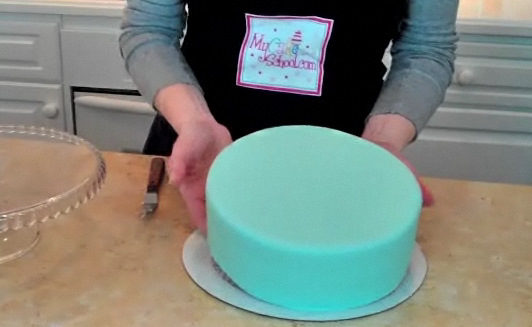
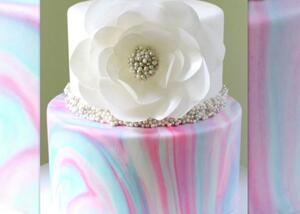
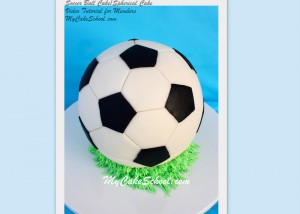
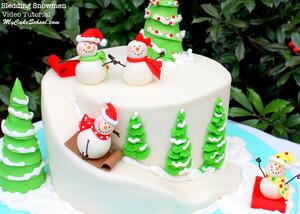
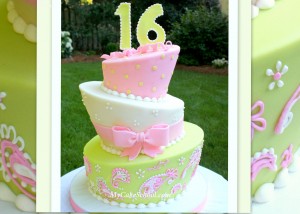
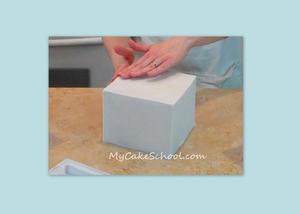
Hey Melissa and Bebe
So I covered a cake yesterday, but for some reason my smoothers kept getting stuck to the fondant and as a result I could not smooth my cakes real nice. I keep putting a little corn flour but it would only work for one movement and then it will be stuck again. Why is that? and what can I do to prevent it?
Thanks in advance :)
Hi Avril--This happens to me every now and then. I think that at times the fondant is a little sticky...due to humidity in the air or even condensation (especially if the fondant was applied to a very cold cake.) . Similar to your strategy, when this happens I dust my cake as well as my smoothers with a little powdered sugar. This usually does the trick for me.
I have to make a fondant covered cake and have never used fondant before. I just watched your video and you make it look sooo easy. I am gonna give it a try. Just one question....would the cake still be fresh enough to serve on a Wed if I bake it on Monday, crumbcoat it and allow it to settle overnight, then
freeze briefly to put fondant on and decorate Tuesday??? Do you allow cakes to settle overnight so that they won't bulge? I have heard you say you can also use a book and set it on top of cake. If I do this method, how long do I leave the book on???
Hi--That timeline sounds just fine!
I do let my cakes settle overnight or at least a few hours with a weight of some sort. Even if I'm able to let a cake settle overnight, I still prefer to have some sort of small weight (thin book, or thick magazine) -- something that will give just a light pressure. We don't want to crush our cake, we just want to encourage it to get all of that settling out of it's system ;0) --
I talk about settling in my "Crumb Coat" video if you'd like to see! Here's a link -
*Just as a little side note, Liz Marek's fondant recipe has become my new favorite. It is a combination of Wilton pre-made fondant and marshmallow fondant. A google search for the recipe will lead you to it if you are interested!
Good luck!
Hi Melissa
Which buttercream recipe do you think works best under fondant? I'm in the Uk so heat isn't to much of an issue but it can still be warm in the summer? Is an all butter frosting that has set better, or your crusting recipe?
Many thanks x
Hi Laura-- Over the years, my preference has really become using ganache beneath fondant rather than buttercream. It just forms such a nice foundation for the fondant, and there are never issues with bulging, etc.
Most buttercream recipes are fine to use with fondant, but we use our "Fluffy" vanilla buttercream recipe most often (which has both butter & shortening). The "high ratio" shortening in the recipes section is the most heat resistant buttercream, as there is no butter and would work fine beneath fondant too. Let us know if you have any more questions!
Hi Melissa great video and very helpful tips thanks so much.
I had a question about fondant ruffles on buttercream yesterday. Where can I find answer ?
Hi Terry- I saw your post come through in the forums yesterday beneath another topic-- Here is the answer that I had posted. Let us know if you have any more questions!
"You can adhere fondant ruffles to the base of a buttercream frosted cake if they are thinly rolled. However, I think that you would like the look of buttercream ruffles too, and it would take a lot less time. I would use the technique from this tutorial:
I don't like the look that I get when using a jumbo petal tip, they are on the thicker/heavier side. I prefer using the more standard 104 tips for ruffles."
Thanks for the quick response I will take your advice
Melissa, once covered in fondant and decorated I will be traveling via car for 6 hours. I therefore need to put my cake in a cake box. I know that you use a cake round the size of your cake - but I am thinking going larger. My cake is 9 inches so I am thinking 12 in Masonite board in a 12 in box. Do you see a problem with that? Or would you put it on a 9 inch round the stick it to the 12 inch board? Thanks
Hi Karen, if it were me, I would have the 9" cake on a 9" board so that it can be easily ganached/frosted on a turntable. The tier is easy to pick up and move when it's on it's own cake board cut down to size. Then, chill just until the frosting or ganache is firm...cover the cake with fondant, and "glue" the tier to it's covered/prepared 12" cake board with frosting, royal, or melted candy melts & decorate as usual. (Of course you can decorate the cake before moving to the 12" board if you'd rather.)
You are right, 12" board and 12" box is a good way to go. Good luck!